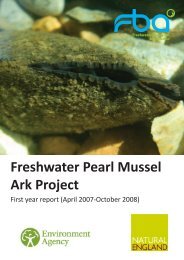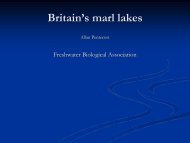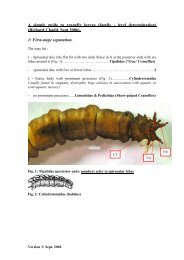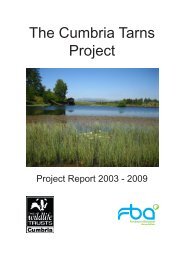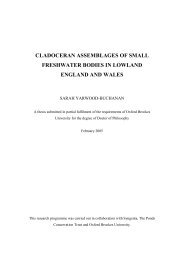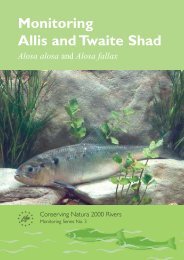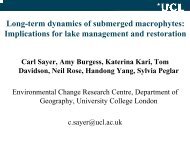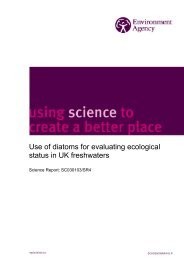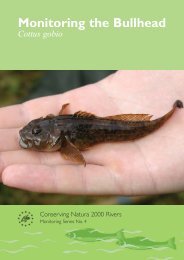Groundwater HIA post edit - FreshwaterLife
Groundwater HIA post edit - FreshwaterLife
Groundwater HIA post edit - FreshwaterLife
You also want an ePaper? Increase the reach of your titles
YUMPU automatically turns print PDFs into web optimized ePapers that Google loves.
distributed and time-variant numerical groundwater model, calibrated and validated<br />
against historical data. This is likely to require the collection of data from a wide range<br />
of sources, including more field investigations. It is likely that Tier-3 assessments will<br />
only be required in a relatively small number of cases.<br />
It is not possible to be prescriptive when describing the tiers, and indeed it is preferable<br />
that as much flexibility as possible is retained throughout the process (the information<br />
and data requirements will become clearer when the <strong>HIA</strong> methodology itself is<br />
described in Section 4).<br />
Box 3.1: Thiem and Thiem-Dupuit equations<br />
3.3 Tools and<br />
techniques<br />
There are many tools and<br />
techniques available that can be of<br />
great help when undertaking <strong>HIA</strong>.<br />
Unfortunately, there is no single tool<br />
or technique that covers everything,<br />
so it is a question of using technical<br />
judgement on when to use which<br />
tool or technique. It is also a<br />
question of being realistic about the<br />
limitations and built-in assumptions<br />
of each tool or technique. Let us<br />
now look briefly at some possible<br />
tools and techniques.<br />
3.3.1 Tier 1 tools<br />
The main tools likely to be used at<br />
the level of Tier 1 are simple<br />
analytical equations and the analysis<br />
of test pumping results. Two good<br />
examples of useful analytical<br />
equations are the Thiem equation<br />
and Thiem-Dupuit equation for<br />
steady-state flow in confined and<br />
unconfined aquifers respectively<br />
(Kruseman and de Ridder 1990).<br />
The equations and parameters are<br />
shown in Box 3.1.<br />
Such equations must always be<br />
used with care, bearing in mind all<br />
the assumptions on which the<br />
equations are based. As part of this<br />
project, over 20 analytical equations<br />
have been assembled from various<br />
sources (textbooks and other<br />
publications), and put into an MS<br />
Excel spreadsheet for convenience,<br />
for use when assessing the impacts<br />
of groundwater abstractions. Many<br />
Thiem equation (steady-state confined flow)<br />
2πKD(<br />
h2<br />
− h1<br />
) 2πKD(<br />
s1<br />
− s2<br />
)<br />
Q =<br />
=<br />
2.<br />
30log(<br />
r / r ) 2.<br />
30log(<br />
r / r )<br />
16 Science Report – Hydrogeological impact appraisal for groundwater abstractions<br />
2<br />
1<br />
Thiem-Dupuit equation (steady-state unconfined flow)<br />
2 2<br />
K(<br />
h2<br />
− h1<br />
)<br />
Q =<br />
2.<br />
30log(<br />
r / r )<br />
π<br />
Both diagrams from Kruseman and de Ridder (1990).<br />
Q = pumping rate [L 3 /T]; K = hydraulic conductivity [L/T];<br />
D = saturated aquifer thickness [L];<br />
hi = elevation of water table or piezometric surface [L];<br />
si = drawdown [L]; ri = radius [L];<br />
where L = length and T = time.<br />
These equations are given here in their most general<br />
form, but they can be used in other ways. For example,<br />
if only one piezometer is available (at distance r2 in the<br />
diagrams above), the water level in, and radius of, the<br />
pumping well (hw and rw) can be used instead of the<br />
'inner' piezometer. However, care must be taken to<br />
allow for the effects of well losses and the breakdown<br />
close to the well of some of the assumptions built into the<br />
equations. The radius of influence (Ro) of a groundwater<br />
abstraction, defined as the radius at which drawdown is<br />
zero, is sometimes estimated by setting h2 to the original<br />
water table or piezometric surface, if all other parameters<br />
are known.<br />
2<br />
1<br />
2<br />
1




